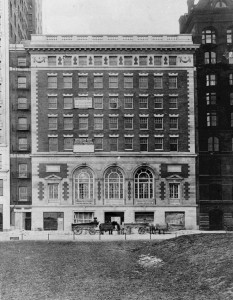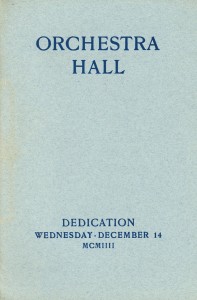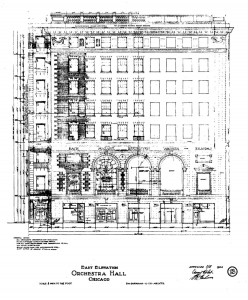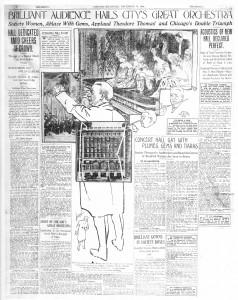
On December 14, 1904, Orchestra Hall first opened its doors with a grand dedicatory concert, with Theodore Thomas leading the Chicago Orchestra along with the Apollo Musical and Mendelssohn clubs.
For nearly the first fourteen years of its history, the Orchestra had performed at
Dankmar Adler and Louis Sullivan’s Auditorium Theatre. However, the hall was far too cavernous for an orchestra; filling 4,000 seats twice weekly was an overwhelming challenge; and there were constant scheduling conflicts with other ensembles. It was rarely a problem getting a ticket to hear the Orchestra, and as a result, season subscriptions were nearly unmarketable.
Thomas initiated a campaign for a new hall, and in 1902 the property at the site of Leroy Payne’s livery stable—on Michigan Avenue between the Pullman Building and the Railway Exchange Building*—became available. Daniel H. Burnham, John J. Glessner, and Bryan Lathrop, along with seven other trustees, initially carried the purchase price, while the Orchestral Association issued an appeal to Chicagoans to secure the $750,000 needed to build a new hall. More than 8,000 individuals contributed.
Ground was broken on May 1, 1904, and seven months later, Thomas led the first rehearsal in the hall on December 6. He sent a telegram to Burnham the next day: “Hall a complete success. Quality exceeds all expectations.”
At the beginning of the dedicatory concert on December 14, Thomas led the Orchestra and choruses in “Hail! Bright Abode” from Wagner’s Tannhäuser. George Everett Adams, second president of the Orchestral Association from 1894 until 1899 (and a trustee from 1894 until 1917) and one of the ten men who helped secure the Michigan Avenue property, was given the honor of delivering an inaugural address. “We have built here a noble hall of music. It is a merely material structure of brick, and stone, and steel. We have not, and we cannot, put into this building its living soul. That is a task for other hands than ours.”
The program continued with the Overture to Tannhäuser, Strauss’s Death and Transfiguration, and Beethoven’s Fifth Symphony—music “devoted to the serious contemplation of the soul, its struggles here, and its triumphs hereafter”—and concluded with “Hallelujah!” from Handel’s Messiah.

Orchestra Hall nearly finished in the late fall of 1904 (note “offices for rent” sign above a ballroom window)
*The Pullman Building was completed in 1885 and demolished in 1956; the Borg-Warner Building was completed in 1958. The Railway Exchange Building, designed by D.H. Burnham & Company, was completed in 1904.
**Burnham’s elevation for the façade of Orchestra Hall included the names of five composers: Bach, Mozart, Beethoven, Wagner, and Brahms. However, it was decided that Brahms was too contemporary (he had only died in 1897), and he was replaced with Schubert. To maintain chronological order, the names were rearranged: Bach, Mozart, Beethoven, Schubert, and Wagner.
This article also appears here.


